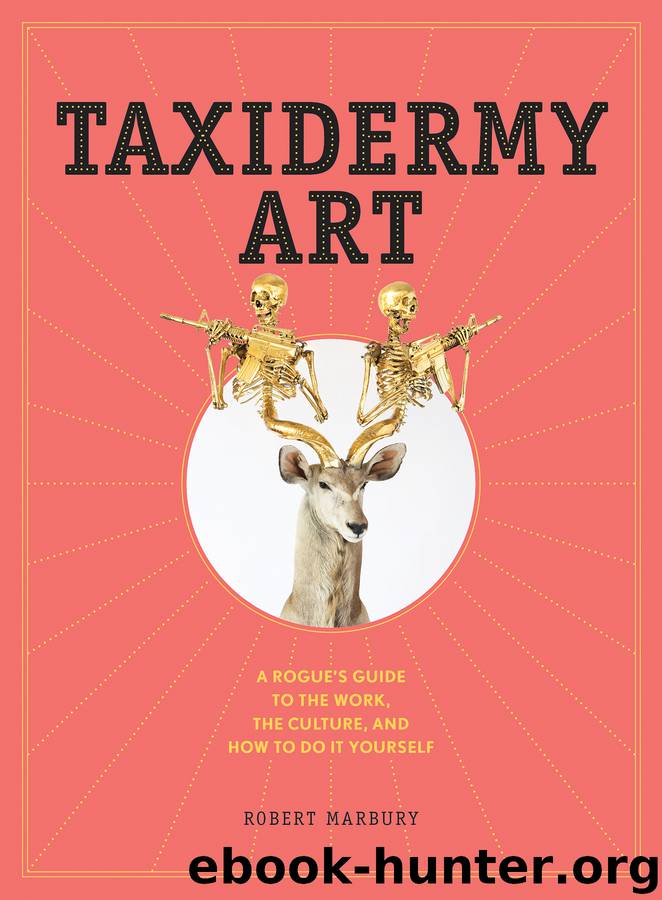Taxidermy Art by Robert Marbury

Author:Robert Marbury
Language: eng
Format: epub
Publisher: Artisan
Documenting Your Work
Make sure to keep notes on each project as you go, including the animal source, mount or filling used, and your process. This will be an enormous help in determining what contributed to a successful or unsuccessful project. In addition to these notes, always take photographs of your work. There is a tendency to rush projects out the door to clients and galleries. But once the piece is gone, you will regret not having a photographic record. While most of us have access to a camera on our cell phones, it pays to invest in a proper camera and a backdrop so that your images are clean, focused, and large enough to print, if need be (or just make friends with a photographer who likes to photograph taxidermy). When taking photos (particularly if you’re going to upload them to the Web), here are a few things to consider:
• Choose carefully whether to photograph a piece on white, black, or in situ. This will be determined in part by the color of the fur. Dark fur gets lost on a dark background without proper lighting, the same for white fur on a white background. A clean white background is generally preferred for mounts that will be posted online for sale.
• Consider photographing some detail shots, in addition to the whole piece. These close-up images will allow you to showcase your craftsmanship as well as create a more intimate perspective of the animal (think wildlife photos that are cropped to show just the animal’s face, paws, or wings).
• More is not always better. Edit your images to those with the best angles and composition. You should overphotograph each piece, but try to limit the images you use to your best selects.
• If your images are going to live on the Internet, add your name to the photographs. That way, if it is shared, it will still lead back to you. Whether you use a watermark or simply layer your name over the image, try to incorporate it so that it is not too much of a distraction, since many websites will just crop anything leading away from their site.
• Select the order of your images when presenting them on your own website or blog so that your audience gets the maximum effect of the piece. For example, you may want to “tease” the piece by starting out with a close-up, then a medium view, and finally a wide shot. Sequencing can make a huge difference in how people experience your work.
Download
This site does not store any files on its server. We only index and link to content provided by other sites. Please contact the content providers to delete copyright contents if any and email us, we'll remove relevant links or contents immediately.
Periodization Training for Sports by Tudor Bompa(8097)
The Body: A Guide for Occupants by Bill Bryson(4887)
The MacArthur Bible Commentary by John MacArthur(4680)
The Sports Rules Book by Human Kinetics(4216)
What It Really Takes to Get Into Ivy League and Other Highly Selective Colleges by Hughes Chuck(3644)
Marijuana Grower's Handbook by Ed Rosenthal(3584)
The Sprouting Book by Ann Wigmore(3510)
The Martian by Andy Weir(3250)
Salt, Fat, Acid, Heat: Mastering the Elements of Good Cooking by Nosrat Samin(3078)
The Bread Bible by Rose Levy Beranbaum(2969)
Sapiens and Homo Deus by Yuval Noah Harari(2944)
Harry Potter 4 - Harry Potter and The Goblet of Fire by J.K.Rowling(2942)
Classic by Mary Berry(2916)
The Marketing Plan Handbook: Develop Big-Picture Marketing Plans for Pennies on the Dollar by Robert W. Bly(2902)
Martha Stewart's Baking Handbook by Martha Stewart(2748)
The Plant Paradox by Dr. Steven R. Gundry M.D(2512)
Screenplay: The Foundations of Screenwriting by Syd Field(2505)
50 Economics Classics by Tom Butler-Bowdon(2484)
The Cambridge Grammar Of The English Language by Rodney Huddleston Geoffrey K. Pullum(2355)
